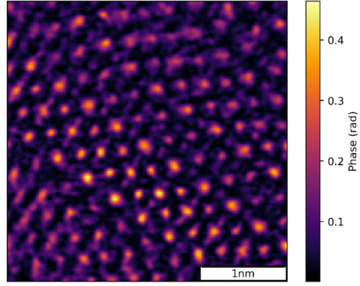
Electron ptychography image of He ion irradiated REBCO coated conductor taken at the ePSIC facility, Diamond Light Source and reconstructed by Dr Fred Allars.
Rare-earth barium copper oxides (REBCO) are the only class of high-temperature superconducting (HTS) materials that have been developed into commercial wires with an engineering performance good enough for use in the high field magnet for small fusion tokamaks like the one being designed in the STEP programme. One of the critical aspects we must understand before deploying these expensive materials in a fusion reactor is how their superconducting properties are affected by exposure to high energy neutrons and a significant flux of gamma rays to ensure that they can retain adequate performance for the lifetime of the magnets.
This project will involve using a combination of electron energy loss spectroscopy in a scanning transmission electron microscope with synchrotron x-ray absorption spectroscopy to characterise irradiation-induced point defects in REBCO. The student will study commercial coated conductor samples and grow their own REBCO films with simpler microstructures and chemistry using our pulsed laser deposition facility. By comparing the defects produced by different irradiating species (e.g. light ions, electrons, protons) with fast neutrons, the aim is to ascertain how reliable these alternative sources of irradiation are as proxy for the kind of neutron bombardment that will be inflicted in a fusion reactor. This is important because neutron irradiation experiments are expensive and slow, as well as resulting in the samples becoming radioactive, which limits the number and range of experiments that can be performed.